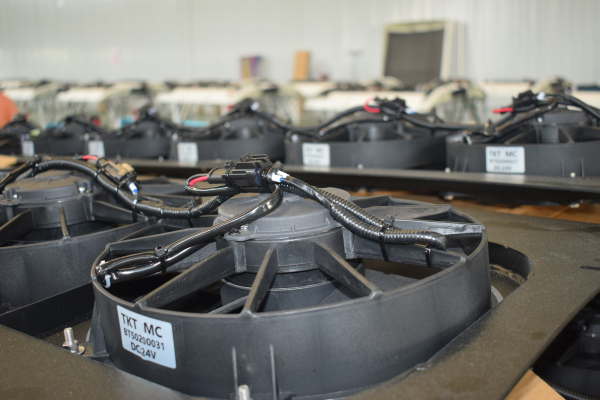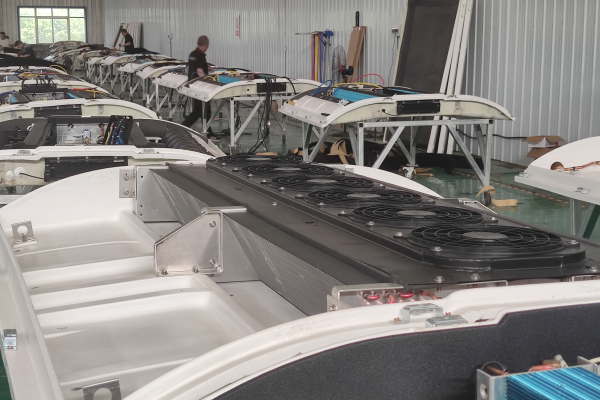
1. Introduction Of EV Bus Air Conditioning System
As the ev bus develops today, we will find that the customer experience is the focus of each vehicle company's competition. Today, we will mainly talk about the
ev bus air conditioning system, which is the most sensitive experience for drivers and passengers.

The main function of the air conditioning system is to regulate the temperature and humidity of the space inside the bus, so that drivers and passengers can enjoy a comfortable hot and humid environment, and its main functions are as follows:
(1) Heating and cooling functions of the air-conditioning system
(2) Air filtration and ventilation of the air conditioning system
(3) Automatic humidity control of the air-conditioning system
(4) defogging and defrosting function of the air-conditioning system.
The requirements for ev bus air conditioning unit are to be able to adjust the environment inside the bus to the most suitable state for the human body under various climatic and driving conditions, to provide a comfortable environment for the passengers, to reduce the fatigue intensity of the driver, and to improve driving safety.
Air-conditioning refrigeration systems by the "compressor-condenser-expansion valve-evaporator" type of steam compressor refrigerant circulating system and air-conditioning wind system, the refrigerant circulating system includes: a compressor, condenser, liquid storage drier, expansion valve, evaporator, regulator and refrigerant, air-conditioning wind system includes: air ducts, fans, air The air conditioning air system includes: air ducts, fans, air filters, adjustable dampers, new air outlets, return air outlets, air supply outlets, etc. The working principle of air conditioning is divided into four steps.


The working principle of air conditioning is divided into four steps as follows:
(1) The low-temperature, low-pressure gaseous refrigerant that absorbs heat through the evaporator in the compartment is compressed by the compressor into a high-temperature, high-pressure gaseous refrigerant and discharged.
(2) High-temperature, high-pressure gaseous refrigerant through the condenser heat condensation into medium-temperature, high-pressure liquid refrigerant, into the liquid storage dryer for drying, and filtration.
(3) After the expansion valve throttling pressure into low-temperature, low-pressure liquid refrigerant, and then into the evaporator.
(4) After absorbing heat in the evaporator, it evaporates into a low-temperature, low-pressure gaseous refrigerant and re-enters the compressor to start the next cycle.
In the above process, the condenser can be used as a heat exchanger outside the bus, and the evaporator can be used as a heat exchanger inside the bus, cooling the bus to achieve the purpose of refrigeration.
For the traditional internal combustion engine ev bus compressor by the engine to provide power to realize the refrigerant to do work. The residual heat of the engine can heat the coolant to realize the heating inside the bus. Therefore, the energy of the air conditioning and warm air systems of traditional automobiles comes from the engine.
The energy of new energy vehicles comes from the power battery, including the energy of the air conditioning compressor to do work on the refrigerant. The waste heat of new energy vehicles is relatively limited, mainly power batteries, motors, and controllers, heat generation is small, low grade, recovery is difficult, and not enough to meet the heating needs of the bus room. The current mainstream heating method of pure electric vehicles is electric heating and heat pump technology, which can be divided into cold air conditioning + PTC system, vapor compressor heat pump system, injection make-up air heat pump system, and other forms.

2. Cold Air Conditioning + PTC System
Traditional ev bus air conditioning and refrigeration systems will compressor drive source from the engine to a high-pressure motor, and then in the air conditioning system air ducts installed in the electric heater, the basic fuel bus air conditioning, and warm air system to make changes, can be applied to new energy vehicles, which is currently the most common form of air conditioning system. Electric heating method for PTC (Positive Temperature Coefficient) element. PTC is the use of BaTiO2 material thermistor positive temperature coefficient characteristics of the development of heating elements. When the gear PTC heater works, the resistance will increase with the temperature, and the heating power decreases, resulting in a decrease in temperature and resistance. When the resistance decreases, the heating power increases and the temperature rises, thus maintaining it within a certain temperature range.
The advantage of this form of air conditioning system is that it is simple in structure, requiring only minor adjustments to the air conditioning system of a conventional fuel vehicle, and is less costly. The disadvantage is that the thermal efficiency is lower than 1, which requires a large amount of electrical energy to be consumed for heating, and has a significant impact on the low-temperature range degradation of electric vehicles. Electrically heated warm air systems can also be divided into two forms PTC air heating and PTC water heating, The air heating form is the use of high-voltage electric PTC direct heating of the air, and the water heating form is the use of high-voltage electric PTC first heated coolant, after the exchange of the warm air through the heated air core body heating the air.
Single-cooled air conditioning + PTC system follows the thermal management system of traditional fuel vehicles, which has a simple structure and good portability and is the simplest solution to the heating problem of electric vehicles. However, the low efficiency of electric heating leads to a serious decline in range, which restricts the operation and development in cold regions and has a poor development prospect. Since PTC heating consumes too much power, the pre-study of heat pump technology has been carried out since 2012, and it has been proved that the heating energy consumption of heat pumps is much lower than that of PTC heating.
Learn more about the products and information about the bus air conditioning system, please feel free to contact the
TKT HVAC team, we provide answers to your satisfaction.







